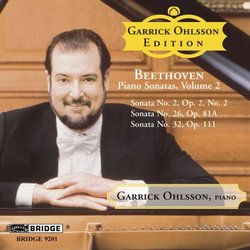The breathtaking performance of Beethoven by Mr. Ohlsson
Vera Kolb | Kenosha, WI | 09/13/2006
(5 out of 5 stars)
"This is Volume 2 of Mr. Garrick Ohlsson's recordings of Beethoven sonatas. It has three sonatas: No.2 in A Major, Op. 2, No. 2, No. 26 in E-flat Major, Op. 81 A, also known as "Lebewohl" or "Les Adieux", and No. 32 in C Minor, Op. 111, Beethoven's last sonata, written at the time when he was completely deaf.
The audience and the experts perceive Mr. Ohlsson's performance and recordings of these sonatas as music events of historic proportions. I notice that even the music critics, who are sometimes supersaturated with good music and thus blasé, have ran out of compliments for Mr. Ohlsson, and are struggling to find new superlatives to describe his musicianship.
The Sonata #2 is a showpiece for Mr. Ohlsson's phenomenal range of dynamics and tone variations. He injects just enough energy into the slow movement to move it forward without destroying its delicate structure. In my case, it is Mr. Ohlsson's playing which makes listening to this sonata memorable, much more so than Beethoven's ideas.
The Sonata No. 26 is relatively popular, and you will recognize it. It was dedicated to Beethoven's pupil and friend, Archduke Rudolphe, who had to flee Austria during the war with French, but has eventually returned. There is a nice description of this sonata in the music notes that accompany this CD. I have heard Mr. Ohlsson perform this sonata at Ravinia. He was playing then the Fazioli piano. On this CD he plays a different piano, with a unique sound, Mason and Hamlin concert grand, 1919, which was rebuilt by William Schneider, Michigan State University.
The music event for me was the last sonata, No. 32, which I have also heard Mr. Ohlsson play at the Ravinia. I relive the experience. In the first movement of this sonata the great message is delivered immediately and is very captivating. Beethoven's drama will get you full attention. Is this Mr. Ohlsson playing, or is it an entire orchestra? It is an admirable performance. Mr. Ohlsson unleashes his power and thunder, only to slide easily to the soft and pensive parts. There is an unbelievably beautiful build of drama towards the end of this movement.
The second movement starts with a sad mood. It is moving beyond belief. It is just plain sadness with no anger or drama. Perhaps Beethoven was at that point resigned to his deafness. What a tragedy! After about 8 min., a playful part, with a dancing rhythm is introduced. Life is not over yet! I just love Beethoven! He gives me hope. The joyous part fades away. A delicate, lace-like music follows, and re-introduces sadness. Beethoven sounds quite impressionistic here. A stronger section with very sad trills follows. The seemingly endless trills just accentuate the sadness, and do not lead to any resolution, since there is none. It is a very dignified and realistic sadness of a very mature person. After about 17 min. Mr. Ohlsson builds the ending with musical finesse, superb taste, great sophistication and an infinite beauty. The movement is over. Bravo, Bravissimo, Bravississimo to both Beethoven and Mr. Ohlsson!
What you have just read is the March 17, 2007 addition to my original review of September 13, 2006, which is shown below. The original review was written after I heard Mr. Ohlsson play in Ravinia, and it reflects my great enthusiasm for Mr. Ohlsson's playing.
This is a breathtaking performance which would make Beethoven envious. Mr. Ohlsson introduces us to the cosmic law of music which comes out of him with a force which will have you shaken to your musical core. Your musical world view will change for better. There will be a longing in your heart, which will draw you back to listening to Mr. Ohlsson again and again, wondering if you, a mere musical mortal, will ever be able to fully assimilate his truly out-of-this-world performance."


 Track Listings (9) - Disc #1
Track Listings (9) - Disc #1